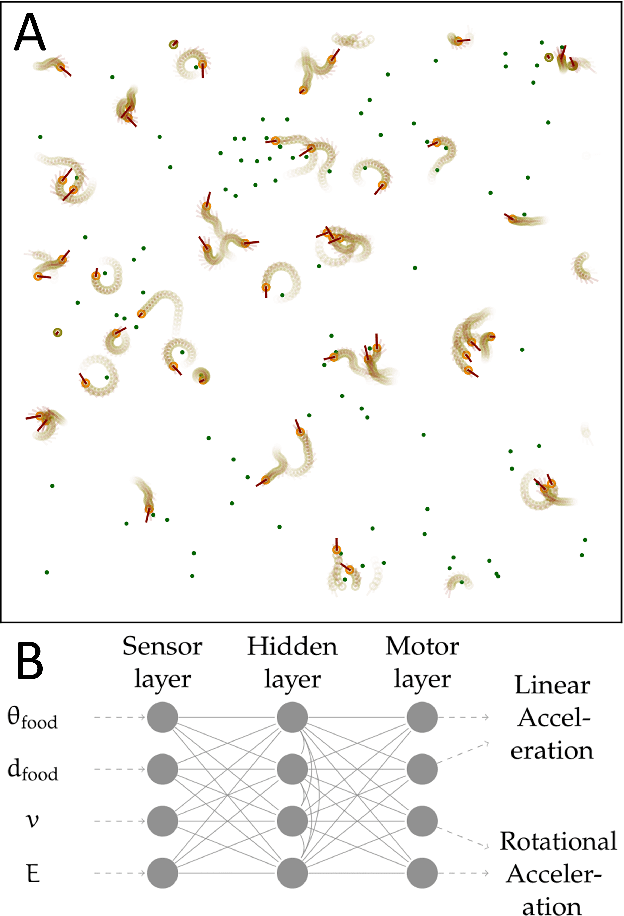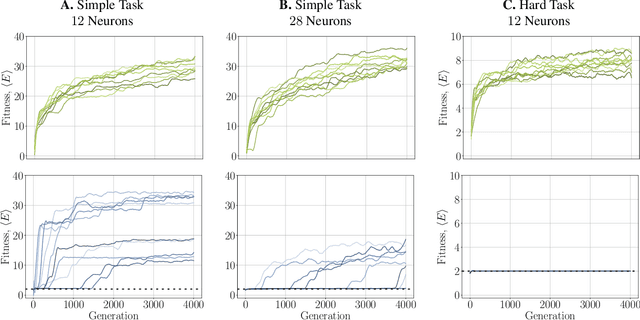Jan Prosi
When to be critical? Performance and evolvability in different regimes of neural Ising agents
Apr 13, 2023Abstract:It has long been hypothesized that operating close to the critical state is beneficial for natural, artificial and their evolutionary systems. We put this hypothesis to test in a system of evolving foraging agents controlled by neural networks that can adapt agents' dynamical regime throughout evolution. Surprisingly, we find that all populations that discover solutions, evolve to be subcritical. By a resilience analysis, we find that there are still benefits of starting the evolution in the critical regime. Namely, initially critical agents maintain their fitness level under environmental changes (for example, in the lifespan) and degrade gracefully when their genome is perturbed. At the same time, initially subcritical agents, even when evolved to the same fitness, are often inadequate to withstand the changes in the lifespan and degrade catastrophically with genetic perturbations. Furthermore, we find the optimal distance to criticality depends on the task complexity. To test it we introduce a hard and simple task: for the hard task, agents evolve closer to criticality whereas more subcritical solutions are found for the simple task. We verify that our results are independent of the selected evolutionary mechanisms by testing them on two principally different approaches: a genetic algorithm and an evolutionary strategy. In summary, our study suggests that although optimal behaviour in the simple task is obtained in a subcritical regime, initializing near criticality is important to be efficient at finding optimal solutions for new tasks of unknown complexity.
* arXiv admin note: substantial text overlap with arXiv:2103.12184
The dynamical regime and its importance for evolvability, task performance and generalization
Mar 22, 2021



Abstract:It has long been hypothesized that operating close to the critical state is beneficial for natural and artificial systems. We test this hypothesis by evolving foraging agents controlled by neural networks that can change the system's dynamical regime throughout evolution. Surprisingly, we find that all populations, regardless of their initial regime, evolve to be subcritical in simple tasks and even strongly subcritical populations can reach comparable performance. We hypothesize that the moderately subcritical regime combines the benefits of generalizability and adaptability brought by closeness to criticality with the stability of the dynamics characteristic for subcritical systems. By a resilience analysis, we find that initially critical agents maintain their fitness level even under environmental changes and degrade slowly with increasing perturbation strength. On the other hand, subcritical agents originally evolved to the same fitness, were often rendered utterly inadequate and degraded faster. We conclude that although the subcritical regime is preferable for a simple task, the optimal deviation from criticality depends on the task difficulty: for harder tasks, agents evolve closer to criticality. Furthermore, subcritical populations cannot find the path to decrease their distance to criticality. In summary, our study suggests that initializing models near criticality is important to find an optimal and flexible solution.
 Add to Chrome
Add to Chrome Add to Firefox
Add to Firefox Add to Edge
Add to Edge